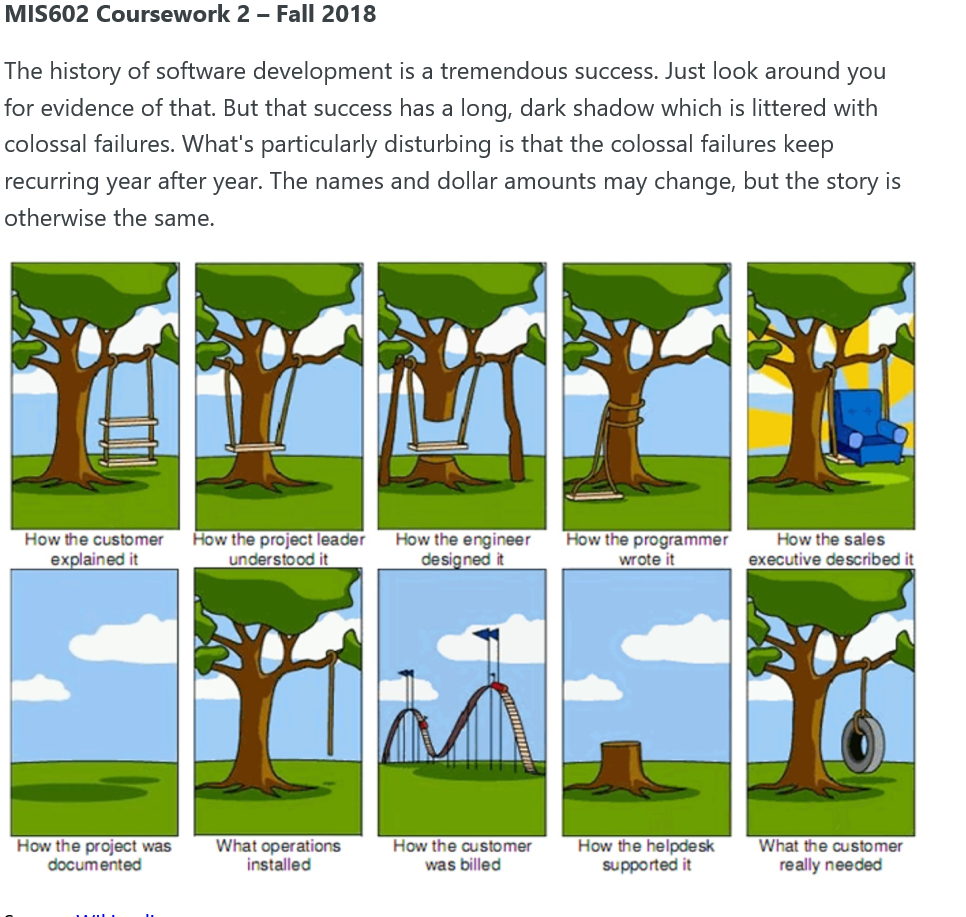Project Management Tree Swing: Funny cartoon, first created in the 1960’s and adapted in 2005, showing how and where projects can go wrong.
Question: As It Applies To The SDLC (software Development Lifecycle) And Briefly Discuss How You Might Eliminate Or At Least Reduce The Impact Of The Above Potential Project Failure Risks In The Swing Cartoon Below. Your Discussion Should Be Written In Terms Of The Key Systems Analysis And Design Tools, Methodologies, Management Methods, And. Nov 08, 2007 Project Cartoon Every now and again, a cartoon comparing building a swing on a tree with the life cycle of software projects resurfaces and we get to laugh a bit. Today I found someone actually made a site about it with some new pictures, merchandising and the ability to create new versions of it.
Today we learnt a little bit more about Digital Project Management thanks to our guest speaker Aisling Mc Mahon, Operations Director from Strata3. This is a subject I was looking forward to, and guess what? It’s not easy work! It’s challenging. There is a lot involved in the development of new projects, organisation and communication are the key to success.
In any given project (these can be banners, mobile apps, websites, intranets and the list goes on!) there are a number of factors or steps that need to be defined first before anything else can be addressed, missing one of these and the process could become overwhelming and unachievable. These are:

- The definitionof the project. Find out what they client is looking for, what they expect from this project, what they like and what they don’t like, ask them why and get them to give you examples. In addition to this, there is a lot of research involved about the market audience, similar products, goals, approach to be taken, maintenance, costs and much more for the final proposal.
- Setting up a budget, specifying the costs for employees, supplies, tools, vendors and other expenses if applicable.
- Define your resources, how much help with you need? what software technology will you have to acquire? who will your suppliers be? etc.
- Define the roles and responsibilities of everyone involved. Communication is vital here, and weekly meetings are recommended to keep every body involved up to date; using a Tracker software can be very helpful as it will not only allow the client to view the status of his project but to also approve or sign off each stage of the project. Every staff member involved can follow the tasks that have been approved, the deadlines and any other relevant information.
- Setting up the deadlines and timings, how long will each stage take? it is very important to stick to it because not meeting the required deadline could mean that the client will end up paying more or the project’s launch might be compromised.
So far, I probably haven’t said anything that doesn’t seem quite obvious and straightforward but managing and developing a project can present many challenges in regards of deadlines, resources, budgets and people. Following the steps is not an easy job and a good project manager would have an appropriate methodology in place, must be a great communicator and organiser, must be consistent, thinks outside the box and is able to see the whole picture.
So, why do projects fail? why do delays happen? how do you prevent and overcome the obstacles?
Cartoon Software Development Tree Swing Game
- Lack of Experience: Very important to have the appropriate level of experience. A Project Manager should be able to tackle all the issues and very comfortable in the involvement of various stages of the project. It’s is also important to highlight that suppliers and other staff members have the appropriate qualification and reputation. When a client knows they are meeting an experience team they are most likely going to go ahead with your company/agency.
- Assumptions: Assuming your client understand what the process will intake is not optional and vice versa. This can lead to misunderstandings. This is the reason why you must document everything accordingly and include as many details as possible.
- Understanding the Requirements: Understanding what’s going on from day 1, this apply to all parties involved. Otherwise misunderstandings will arise as mentioned above.
- Expectations and Ambitions: Are these too high? are they achievable? can the clients budget get what they desire? These need to be addressed from the beginning.
- Content: Someone is responsible for writing down the content, most of the time this is a task for the client, as they know better than anybody else their product or services. Many times clients take too long to deliver this content and delays may occur.
- The Design Process: Designers might take longer than what you can afford, as a consequence, Developers might be affected and will have to complete complicated tasks in a shorter amount of time.
- Contingency Planning: Always have a plan B! Expect the unexpected, not everything will go according to plan and a good project manager knows this! Having a plan B can save you time and money.
- The Client: A client might want features that are not suitable for their goals or they might even want something that is outdated or doesn’t look good, advice them about this and make suggestions of what could be better for them, sometimes you might have to put the extra work to show them there is a better way. A client might also want to change their mind, if you can accommodate their requirements go ahead but make sure you get paid for the work, the client needs to understand that additional changes have a cost.
- Testing: Don’t forget to add additional time for testing. Most of the time you will encounter bugs and you will need time to fix them. This should be done as many times as necessary until no bugs are found.